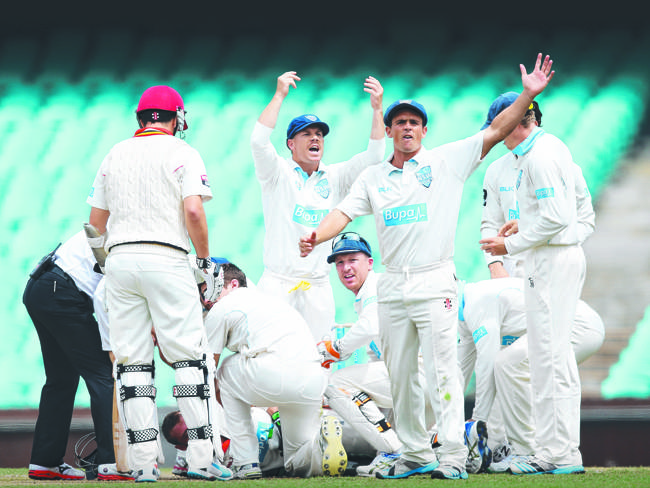Tributes flow for Phillip Hughes 1:42

Tributes are flowing all over the country after the sudden passing of cricketer Phillip Hughes.
- Sky News
- 27 Nov 2014
- News
IT was a freak blow that has only ever killed 100 people — and until yesterday, only one of those by a cricket ball.
Batsman Phillip Hughes became the second after being hit in the neck by a 135km/h bouncer that split one of the main arteries carrying blood to his brain, a devastating and rare brain injury medically defined as a vertebral artery dissection leading to subarachnoid haemorrhage.
LEAVE YOUR MESSAGES ON OUR TRIBUTE WALL
THERE’S NO SENSE IN SUCH A SAD LOSS
DAD GREG WAS ALWAYS BY HIS SON’S SIDE
HIS GREATEST BATTING PERFORMANCES

NSW players call for help as Phillip Hughes falls to the ground after being struck in the head by a delivery during Sheffield Shield match NSW v SA at the SCG. Source: DailyTelegraph
In an emotional press conference after his death, Australian team doctor Peter Brukner described how Hughes “momentarily stood up and then immediately collapsed to the ground”.
He said the blow caused the artery in his neck to split and for bleeding to go up into the brain.
“This was a freakish accident because it was an injury to the neck that caused haemorrhage in the brain. It is incredibly rare, it is called vertebral artery dissection leading to subarachnoid haemorrhage.

Source: DailyTelegraph
“If you look in the literature there is only about 100 cases ever reported … only one previous case has ever been reported as a result of a cricket ball,” said Dr Brukner. “He had a massive bleed into his brain. This is frequently fatal at the time.”

Phillip Hughes is struck on the head. Source: DailyTelegraph
Dr Brukner described how Hughes received immediate care from cricket NSW doctor John Orchard and intensive care specialist Dr Tim Stanley, who was in the crowd at the time and rushed to help.
Dr Brukner also praised the paramedics who arrived and took Hughes to St Vincent’s Hospital 1.5km away for treatment.
YOU COULDN’T HELP BUT SMILE AROUND HIM
INDIA TOUR MATCH CANCELLED, OTHERS DELAYED
HUGHES A TOUGH BATSMAN TO THE VERY LAST

Phillip Hughes is loaded into the back of an ambulance. Source: News Corp Australia
“It is important to realise that, yes, we certainly need to review all our procedures and equipment but this is an incredibly rare type of injury,” he said. Dr Tony Grabs, St Vincent’s head of trauma surgery, said Hughes arrived well resuscitated but “the head injury that he suffered was catastrophic”.

Phillip Hughes celebrates his maiden first class century. Source: News Corp Australia

Macksville High School … Phillip Hughes in 2005. Source: News Limited
He said that Hughes was then given a CAT scan which revealed the alarming picture — the space between his brain and skull was filling with blood from the split artery.
“Once we had made the diagnosis of blood around the brain, and it is subarachnoid blood which is under pressure from the artery, the immediate transfer to surgery was necessary,” said Dr Grabs.

NSW players and medical staff assist Phillip Hughes after he fell to the ground. Source: News Corp Australia
“He went to theatre and had extensive surgery to remove some of the skull around his brain to help allow the brain to expand so that it wasn’t compressed.”
He was then placed into an induced coma to give his brain and bodily functions time to recover.
“Over a period of the first 24 to 48 hours, as we know, he did not make very much improvement and unfortunately as a consequence of the injury he died,” he said.
“We haven’t seen, at this hospital, this type of injury, so it is very rare, very freakish.”
Originally published as Injury so rare hospital hadn’t seen it before
